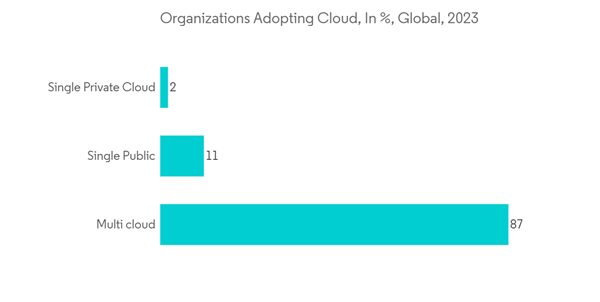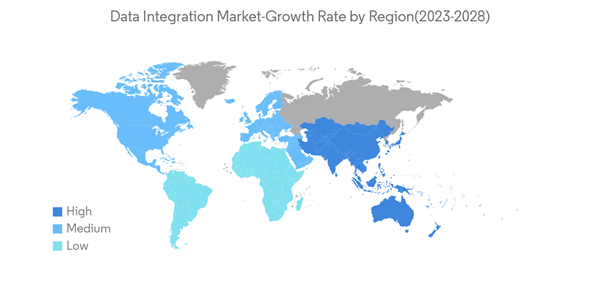Key Highlights
- Data integration is the process of combining data from different sources in order to obtain a single, coherent view. Transformation, cleansing, extract, transform, and load mapping are a few processes involved in data integration. With the help of data integration, analytical solutions are capable of providing valuable and accurate business intelligence.
- The integration of data gives the business intelligence application, irrespective of source or format, a clear view of an organization's data and allows it to provide accurate insight based on its own data assets. It was realized by businesses that the single most practical way of maximizing its potential is to integrate data. With all the information at their disposal in one place, enterprises will find and use the very relevant and accurate insights inside it. They benefit from an advantage over competitors as they can apply such insights for strategic purposes in their business operations.
- The cloud sector will grow significantly over the next few years. The main objective of cloud platforms is to create a unified data store that can be accessed by all applications and users transparently and efficiently. The integration of data in cloud computing refers to technology and tools that connect individual systems, IT environments, repositories, and applications for exchanging real-time data. It also includes connecting different data from multiple systems when the endpoint is a cloud provider, such as Google Cloud or Oracle Cloud, among others.
- With the rising availability of cloud data, as well as new markets and players in this field, it is an opportune time for retailers to assess their data assets and generate new income flows that can sustain and potentially drive development in their business. This data integration may provide the current businesses with the vitality needed.
- The growing collaborations to maximize the cloud data integration are analyzed to significantly drive the market growth rate. For instance, in August 2022, Nagarro, an IT services management firm, partnered with Zendesk, which provides cloud-based software. This initiative would provide for a unified view of the dashboard and simple integration with customer data by Nagarro's IT clients through Zendesk's open, flexible platform. It will also make agents more productive, in addition to the personalization of client interactions and automation of proactive services at scale.
Data Integration Market Trends
Increasing demand for cloud computing technologies
- The shutdown of offices, schools, and enterprises caused by the COVID-19 pandemic increased the demand for cloud solutions and services worldwide. The acceptance of the 'work-from' culture across public and private sectors has resulted in high demand for SaaS-based collaboration solutions, which employees use to communicate with each other. Cloud solution providers partnering with major cloud providers like Amazon Web Services (AWS), Microsoft Azure, and Google Cloud expect significant growth in their cloud services businesses as agility and rapid scalability become necessary for many customers.
- The rapid adoption of cloud-based business processes has encouraged companies to acquire data management capabilities to manage the vast amount of data that is being generated. The advancement in multi-cloud computing is driving the growth of data centers globally, leading to an increased demand for the data integration market.
- The increase in data has been accelerated by emerging technologies contributing to exponential data growth. These technologies are Edge Computing, 5G networking, Artificial intelligence and machine learning (AI and ML), Augmented and virtual reality (AR/VR), Blockchain, and the Internet of Things (IoT). The unprecedented data volume, variety, and speed increase have increased data integration adoption.
- In November 2022, Qlik, a data integration platform and analytics provider, launched a cloud-based new data integration platform service that gathers data from disparate sources in real-time. The platform consists of a set of services that form the data fabric and are interconnected to make it possible for organizations to create one single view of their data.
North America is Analyzed to Hold Largest Share in the Market
- North America is an early adopter and host to innovative initiatives for advanced analytics solutions and practices, such as big data, machine learning, information science, and high-performance computing. Additionally, the region has a strong foothold of vendors, contributing to the market's growth.
- Traditionally, organizations have been gaining benefits from transformation initiatives across technology and business process domains. Recent technology improvements, regulatory developments, and consumer behavior are all converging to usher in this data-led transformation. Social networking sites like Pinterest, Twitter, and Facebook possess comprehensive information. In contrast, retail sites such as eBay and Amazon have taken user experience and expectations to an entirely different level.
- The United States is the most prominent market for analytics, buoyed by the presence of a large number of companies investing heavily to develop more sophisticated data analytics and data integration platforms through advanced feature engineering. For instance, in November 2022, VMware, Inc. announced the number of VMware Sovereign Cloud providers across the globe has more than doubled to 25 partners. VMware has also announced the VMware Aria Operations Compliance pack for sovereign clouds, VMware Tanzu on the sovereign cloud, and new open ecosystem solutions. With sovereign SaaS, VMware Sovereign Cloud Providers can build highly differentiated solutions to capture modern workloads, simplify operations with continuous compliance monitoring, and support data integration with lower risk.
- Further, the growing collaborations in the region are analyzed to bolster the market growth rate during the forecast period. For instance, in February 2023, Siren and DarkOwl entered into a new Data Integration Partnership. Siren provides investigators and data scientists with an insight into risks, such as national security threats, public safety issues, fraud, compliance, or the threat to large enterprise corporations by pooling together information from open source, vendor, and classified sources. For the purpose of conducting robust OSINT investigations, researchers are able to combine findings from a variety of disparate sources using Siren Graph Browser.
Data Integration Industry Overview
The data integration market could be more cohesive, featuring a substantial number of players. To foster market growth during the forecast period, several strategies, including collaborations, product innovations, and acquisitions, have been analyzed.In July 2023, a strategic partnership between Atturra and Denodo brought data virtualization capabilities to Data and Integration Services. This collaboration empowers enterprises to maximize the value of their distributed data sets through logical data fabrics and data mesh capabilities. Moreover, it enhances Atturra's data storage and integration capabilities. Denodo's logical data management platform offers unified and user-friendly data access, which is particularly valuable in complex and diverse data environments.
In May 2022, Informatica, a provider of data integration software and services, allied with Oracle's enterprise connectivity and automation platform. This partnership aims to provide enterprise Analytics, Data Warehouses, and Data Science with cloud data integration and governance solutions. By transitioning on-premise workloads to the cloud platform, both companies' customer bases will benefit from automated data generation.
Additional Benefits:
- The market estimate (ME) sheet in Excel format
- 3 months of analyst support
This product will be delivered within 2 business days.










